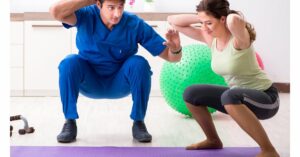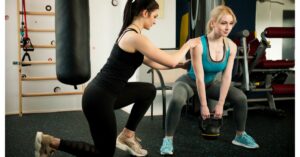Hey there, fitness enthusiasts! Are you a fan of squats but find yourself struggling with the infamous ‘heel raise’ during your workouts?
You’re not alone! In this blog post, we’re diving headfirst into the world of heel raising during squats, exploring its causes, consequences, and most importantly, how to fix it.
So, if you’ve ever wondered whether those lifted heels are good or bad news, stick around because we’ve got the answers you’ve been looking for.
Exploring whether the heel Raising during squats is bad or not.
Heel raising during squats is generally considered suboptimal and can be a sign of poor squatting form.
It’s important to maintain proper form during squats to minimize the risk of injury and to effectively target the muscles you want to work.
Here’s some context and specifics about heel raising during squats:
- Causes of Heel Raising:
- Lack of Ankle Mobility: One of the most common reasons for heel raising is limited ankle mobility. If your ankles cannot dorsiflex (bend forward) adequately, your body may compensate by raising your heels to maintain balance.
- Poor Technique: Sometimes, people raise their heels because they are not properly engaging their core, hips, and glutes. This shifts the weight forward onto the toes.
- Issues with Heel Raising:
- Knee Strain: Raising your heels can place excessive stress on your knees, potentially leading to discomfort or injury.
- Reduced Muscle Activation: Raising your heels may reduce activation of important lower body muscles like the quadriceps, hamstrings, and glutes, which are essential for an effective squat.
- Balance and Stability: Heel raising can compromise your balance and stability, making it harder to perform squats safely.
- Corrective Actions:
- Work on Ankle Mobility: Incorporate ankle mobility exercises into your routine to improve dorsiflexion. This can involve calf stretches, ankle circles, or using a foam roller.
- Proper Footwear: Ensure you’re wearing appropriate footwear with a flat sole that provides stability.
- Focus on Technique: Concentrate on maintaining a neutral spine, pushing your hips back, and engaging your core and glutes as you squat. This will help distribute the weight properly.
- Alternative Squat Variations:
- Box Squats: These involve squatting onto a box or bench, which can help with balance and form.
- Goblet Squats: Holding a weight close to your chest can help counterbalance any tendency to lean forward.
- Front Squats: This variation places less stress on the lower back and may help with maintaining proper form.
- Consult a Professional: If you’re struggling with heel raising during squats or experiencing discomfort, it’s a good idea to consult a fitness professional or physical therapist. They can assess your form and provide personalized guidance to address any issues.

In other words, heel raising during squats is generally considered undesirable due to its potential to compromise form, increase the risk of injury, and reduce muscle activation.
It’s essential to work on ankle mobility and proper technique to perform squats safely and effectively.
Further Explanations.
Let’s dive deeper and elaborate further on all the points mentioned.
Firstly though, let’s dive deeper into the causes and issues related to heel raising during squats:
Causes of Heel Raising:
Lack of Ankle Mobility: This is a common cause of heel raising during squats. Ankle mobility refers to the ability of your ankle joint to move through its full range of motion.
When you squat, your knees should move forward, and your ankles should dorsiflex (bend forward) to allow this.
If your ankles lack the necessary mobility, they won’t be able to flex adequately. As a result, your body compensates by lifting the heels off the ground to maintain balance.
Consequences: Limited ankle mobility can lead to an inefficient squatting pattern. It can also put strain on the knees and reduce the effectiveness of the squat by altering the distribution of forces throughout your lower body.
Poor Technique: Sometimes, people raise their heels during squats because they are not performing the movement with proper technique.
Squats should engage multiple muscle groups, including the core, hips, and glutes. If you’re not engaging these muscles correctly, you may lean forward or shift your weight onto your toes.
Consequences: Poor technique can result in improper muscle activation and balance issues. It can also increase the risk of injury, especially to the lower back and knees, as the load may not be distributed correctly.

Issues with Heel Raising:
Knee Strain: When your heels rise during squats, it can place excessive stress on your knees. This is because the movement pattern shifts forward, and your knees may move past your toes. The knee joint is not designed to handle such forward stress, which can lead to discomfort, pain, or even injury over time.
Consequences: Persistent knee strain can lead to issues like patellar tendinitis or other knee problems, potentially sidelining your workouts.
Reduced Muscle Activation: Raising your heels can reduce the activation of key lower body muscles like the quadriceps, hamstrings, and glutes. These muscles are essential for generating power and stability during a squat.
Consequences: Reduced muscle activation means you’re not getting the full benefit of the squat exercise. It can hinder muscle growth, strength gains, and overall progress in your fitness goals.
Balance and Stability: Heel raising compromises your balance and stability during squats. When your weight shifts forward onto the toes, it becomes harder to maintain an upright posture and control the movement.
Consequences: Poor balance and stability increase the risk of falling or losing control of the weight, which can result in injuries or accidents.
In essense, addressing the causes and issues related to heel raising during squats is crucial for maintaining proper form, reducing the risk of injury, and maximizing the effectiveness of the exercise.
Working on ankle mobility, perfecting your technique, and being aware of the potential consequences of heel raising can help you perform squats safely and with better results.
let’s go into more detail about the corrective actions and alternative squat variations you can consider if you’re experiencing heel raising during squats:
Corrective Actions:
Work on Ankle Mobility: Improving ankle mobility is essential for addressing heel raising. Here are some ankle mobility exercises to incorporate into your routine:
Calf Stretches: Stretch your calf muscles by placing one foot behind you and keeping the heel on the ground while gently pushing your hips forward. Hold the stretch for 15-30 seconds on each leg.
Ankle Circles: Sit or stand with your feet flat on the ground, and then draw circles with your toes, both clockwise and counterclockwise.
Foam Rolling: Use a foam roller to massage and release tension in the calves and shins.
Consequences: Improved ankle mobility will allow your ankles to bend forward more easily during squats, reducing the need to lift your heels.
Proper Footwear: Wearing appropriate footwear is crucial for squatting. Choose shoes with a flat sole and good arch support. Weightlifting shoes or minimalist shoes with a solid base are often recommended.
Consequences: Proper footwear provides stability and helps maintain a solid connection with the ground, reducing the likelihood of heel raising.
Focus on Technique: Correct technique is paramount for preventing heel raising. When squatting, pay attention to the following:
Neutral Spine: Keep your back straight and maintain a neutral spine throughout the movement. Avoid rounding or arching your back excessively.
Hip Engagement: Push your hips back as you initiate the squat, as if you’re sitting back into a chair. This ensures that your weight is distributed properly between your heels and the balls of your feet.
Core and Glute Engagement: Engage your core muscles and glutes to provide stability and power during the squat. This helps prevent forward leaning.
Consequences: Proper technique ensures that you are using the correct muscle groups and maintaining balance, reducing the risk of heel raising.
Alternative Squat Variations:
Box Squats: Box squats involve squatting onto a box or bench. This variation can be helpful for improving balance and form. To perform a box squat, squat down until your buttocks touch the box, and then stand back up.
Goblet Squats: Goblet squats involve holding a weight (such as a kettlebell or dumbbell) close to your chest while squatting. This helps counterbalance any tendency to lean forward and promotes an upright posture.
Front Squats: Front squats shift the barbell’s position to the front of your body, which can help with maintaining proper form. This variation also places less stress on the lower back compared to back squats.
Consequences: These alternative squat variations can help you work on your squat form, balance, and muscle engagement while reducing the risk of heel raising.
Consult a Professional:
If you continue to struggle with heel raising during squats despite trying corrective actions and alternative variations, it’s advisable to seek guidance from a fitness professional or physical therapist.

They can provide personalized feedback, assess your form, and offer tailored recommendations to address any specific issues you may have.
In summary, a combination of ankle mobility work, proper footwear, technique refinement, and alternative squat variations can help you overcome heel raising during squats and perform this exercise safely and effectively.
Consulting a professional can be especially beneficial if you encounter persistent challenges.
A tabular on this.
Here’s a tabular representation summarizing the key points about heel raising during squats:
| Aspect | Heel Raising During Squats |
|---|---|
| Causes | Lack of Ankle Mobility: Limited dorsiflexion in the ankles, Poor Technique: Improper form, not engaging core and hips. |
| Issues | Knee Strain: Increased stress on knees, Reduced Muscle Activation: Less engagement of key lower body muscles, Balance and Stability: Compromised balance and stability. |
| Corrective Actions | – Work on Ankle Mobility: Calf stretches, ankle circles, foam rolling. – Proper Footwear: Shoes with a flat sole. – Focus on Technique: Maintain a neutral spine, hip engagement, core, and glute activation. |
| Alternative Squat Variations | – Box Squats: Squat onto a box or bench. – Goblet Squats: Hold weight close to chest. – Front Squats: Shift barbell to the front. |
| Professional Guidance | Consult a fitness professional or physical therapist for personalized advice if issues persist. |
| Consequences | Increased risk of knee strain, reduced muscle activation, and compromised balance and stability. |
| Overall Impact | Heel raising can lead to poor form, potential injury, and reduced effectiveness of squats. |
This table provides a concise overview of the causes, issues, corrective actions, alternative variations, and the importance of seeking professional guidance when dealing with heel raising during squats.
Conclusion.
In conclusion, heel raising during squats is generally undesirable due to its association with poor form, increased risk of injury, and reduced muscle engagement.
Addressing the root causes, such as limited ankle mobility and technique issues, is crucial. Corrective actions, proper footwear, alternative squat variations, and professional guidance can help mitigate this issue, allowing for safer and more effective squatting workouts.

Hey there, it’s Mike Rrsq, the Editor-in-Chief over at Jsquat.com, and I’m absolutely obsessed with all things squat fitness! I’ve been lucky enough to get some serious recognition for my work in this field. With a solid background in the fitness and wellness industry, I’ve been there right from the get-go, helping shape this website into what it is today.
You see, I’m not just the boss around here; I’m also a passionate contributor. I love sharing my insights through my articles, and trust me, they’re not your run-of-the-mill stuff. Each piece I write is a labor of love, filled with my expertise and real-world experience in the fitness universe. So, if you’re into fitness and looking for some inspiration, you’re in the right place!

